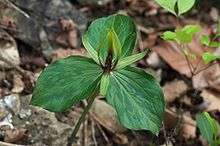Trillium viridescens
Trillium viridescens, also known as the Ozark trillium[2] or tapertip wakerobin,[3] is a species of flowering plant in the family Melanthiaceae. It is found in parts of Arkansas, Missouri, Oklahoma, Kansas, Texas and Louisiana.[4][5] It usually grows in rich deciduous forests and mountain ranges[6] where the soil is clayey and calcareous.
| Trillium viridescens | |
|---|---|
 | |
| Scientific classification | |
| Kingdom: | Plantae |
| Clade: | Tracheophytes |
| Clade: | Angiosperms |
| Clade: | Monocots |
| Order: | Liliales |
| Family: | Melanthiaceae |
| Genus: | Trillium |
| Species: | T. viridescens |
| Binomial name | |
| Trillium viridescens Nutt., 1835 | |
Trillium viridescens is a perennial herbaceous plant that blooms early April to mid May.[2] The flower usually has bi-colored petals, purplish near the base and green above.[7] The species is 2 feet (0.61 m) high.[6]
Bibliography
- Case, Frederick W.; Case, Roberta B. (1997). Trilliums. Portland, Oregon: Timber Press. ISBN 978-0-88192-374-2.CS1 maint: ref=harv (link)
gollark: Coooooooooooooo0l.
gollark: Just wait an hour for one nebula to come off arbitrary transfer/abandon cooldown.
gollark: Unless you have a magi who can teleport now.
gollark: I can send you a spare CB egg when my magi is off cooldown in two days.
gollark: 'Tis gone.
References
- "Trillium viridescens". NatureServe Explorer. NatureServe. Retrieved May 2, 2008.
- Case Jr., Frederick W. (2002). "Trillium viridescens". In Flora of North America Editorial Committee (ed.). Flora of North America North of Mexico (FNA). 26. New York and Oxford – via eFloras.org, Missouri Botanical Garden, St. Louis, MO & Harvard University Herbaria, Cambridge, MA.
- "Trillium viridescens". Natural Resources Conservation Service PLANTS Database. USDA. Retrieved 15 December 2015.
- "Trillium viridescens". County-level distribution map from the North American Plant Atlas (NAPA). Biota of North America Program (BONAP). 2014. Retrieved 7 October 2019.
- Thomas E. Hemmerly (2002). Ozark Wildflowers. University of Georgia Press. p. 114. ISBN 0-8203-2336-5. LCCN 2001047648.
- Carl G. Hunter (2000). Wildflowers of Arkansas. Ozark Society Foundation. p. 44. ISBN 9780912456164.
- Nathaniel Lord Britton; Addison Brown (1913). An Illustrated Flora of the Northern United States, Canada and the British Possessions. 1 (2nd ed.). Charles Scribner's Sons. p. 524.
External links
This article is issued from Wikipedia. The text is licensed under Creative Commons - Attribution - Sharealike. Additional terms may apply for the media files.
